
AI forecasting tools are transforming how businesses predict trends, manage inventory, and plan finances. With options ranging from basic demand planning to enterprise-grade solutions, choosing the right platform can be challenging. Here's what you need to know:
| Tool | Best For | Starting Price | Key Strength |
|---|---|---|---|
| Netstock | Inventory management | Custom pricing | SKU-specific demand planning |
| Lokad | Probabilistic inventory planning | Custom pricing | Multi-scenario forecasting |
| Logility | Supply chain optimization | $50,000+ (implementation) | ERP integrations, scalability |
| Planful | Financial planning | Subscription-based | Continuous planning flexibility |
| Workday Adaptive | Enterprise financial planning | Subscription-based | HR and financial integration |
| Vena | Excel-based financial planning | Subscription-based | Familiar interface, ease of use |
| GMDH Streamline | Inventory forecasting | $500/month | Budget-friendly, automated models |
| Avoma | Sales conversation analysis | Per-user subscription | NLP-driven sales insights |
| Anaplan | Enterprise-wide planning | Custom pricing | Scenario-based forecasting |
Each platform has its strengths and limitations. Large enterprises often favor scalability and integration, while smaller businesses benefit from cost-effective, easy-to-use solutions. The right choice depends on your business goals, industry focus, and budget.
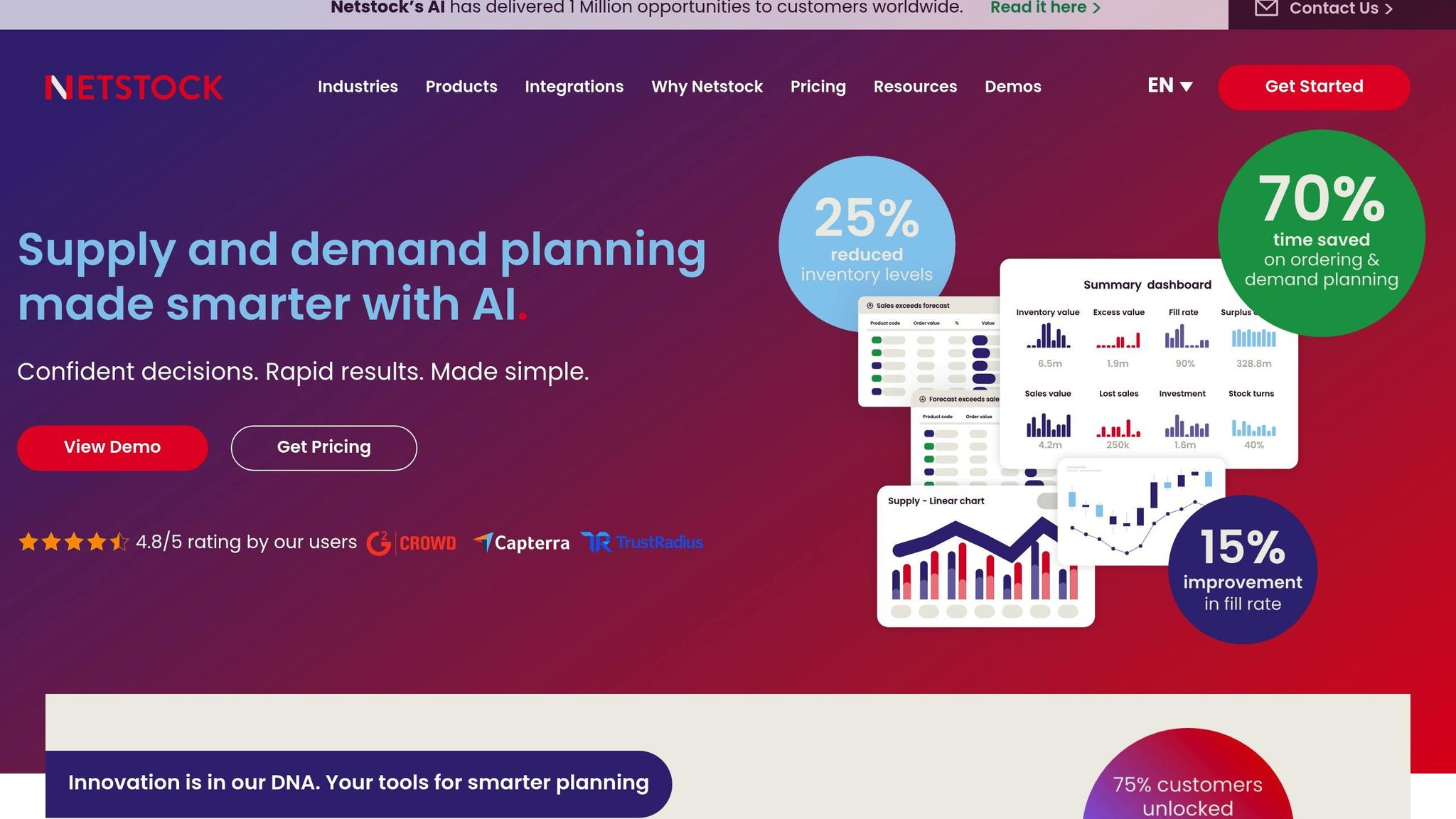
Netstock kicks off our comparison by showcasing how AI-driven forecasting can revolutionize inventory management for U.S.-based businesses.
This platform is designed specifically for manufacturers, distributors, and retailers managing extensive inventories. Netstock caters to companies grappling with the challenges of forecasting across thousands of SKUs, offering a demand planning solution tailored to their needs.
Netstock's forecasting engine, Pivot Forecasting®, combines statistical models with advanced AI to deliver tailored demand predictions. It automatically selects and fine-tunes forecasting models for each SKU, factoring in seasonality, market volatility, and unexpected demand shifts.
The platform supports a variety of statistical models, such as Moving Averages, Exponential Smoothing (single, double, and triple/Holt-Winters), Linear Regression, ARIMA, and Seasonal Decomposition. For more intricate scenarios, it employs advanced techniques like Multivariate Regression, Machine Learning models (e.g., gradient boosting, random forests, decision trees, neural networks), Causal Modeling, and Hybrid Approaches.
What makes Netstock stand out is its AI-powered algorithm detection, which uncovers subtle demand signals that traditional statistical methods often overlook. These machine learning algorithms analyze massive datasets, identifying complex relationships that might otherwise go unnoticed.
The platform continuously adapts as new data comes in, ensuring forecasts remain accurate even in unpredictable markets. It can generate forecasts across various dimensions - by sub-SKU attributes, customer, channel, or region - using monthly, weekly, or daily intervals.
Another valuable feature is its ability to spot outliers like seasonal trends, promotional effects, and unique events. For added flexibility, users can manually adjust forecasts for scenarios such as new product launches, shifting customer bases, or promotional campaigns. The system even tracks whether these manual changes improve accuracy by measuring bias between over- and under-forecasting.
Netstock integrates seamlessly with major ERP systems, including Microsoft Dynamics Business Central. A great example is The Little Potato Company (TLPC), which implemented Netstock across three production facilities and eight distribution centers. By dynamically adjusting safety stock levels, TLPC boosted its fill rate from 90.9% to 98%.
Another success story comes from Shimano North America Bicycle Inc., which used Netstock's Predictor IBP solution to manage over 60,000 items. The direct integration with their ERP system provided real-time insights, enabling more precise inventory management.
"We were amazed at the flexibility and depth of the analysis that we were able to perform. We can easily select the customers that we want to forecast individually. Previously, these types of changes would have required IT prioritization and took much longer to complete. Now, we can add new key customers or channels, experiment with alternative hierarchies and roll-ups, and formulate new insights, all without consuming valuable IT resources." - Sr. Manager of Supply Chain, Shimano
Netstock is built to handle large-scale operations. Its architecture can manage complex product hierarchies across multiple facilities and distribution centers. The platform assigns optimal forecasting models for each item, whether based on customer, region, unit, price, cost, or margin, making it a fit for businesses with intricate product structures.
The platform also supports advanced features like multi-item manual adjustments, group seasonal forecasting for sparse data, and disaggregation. For instance, it can consolidate sales data by region for more reliable predictions, then distribute those forecasts back to individual store locations.
Netstock uses a custom pricing model, meaning you’ll need to contact the company for a quote. After answering a few qualification questions, prospective customers can receive tailored pricing information.
Although exact pricing details aren’t disclosed, Netstock highlights its value through customer success stories. For example, Conmed Corporation achieved full payback on both software and implementation costs in just two months.
"We got a full payback on the software and implementation in about two months." - Conmed Corporation
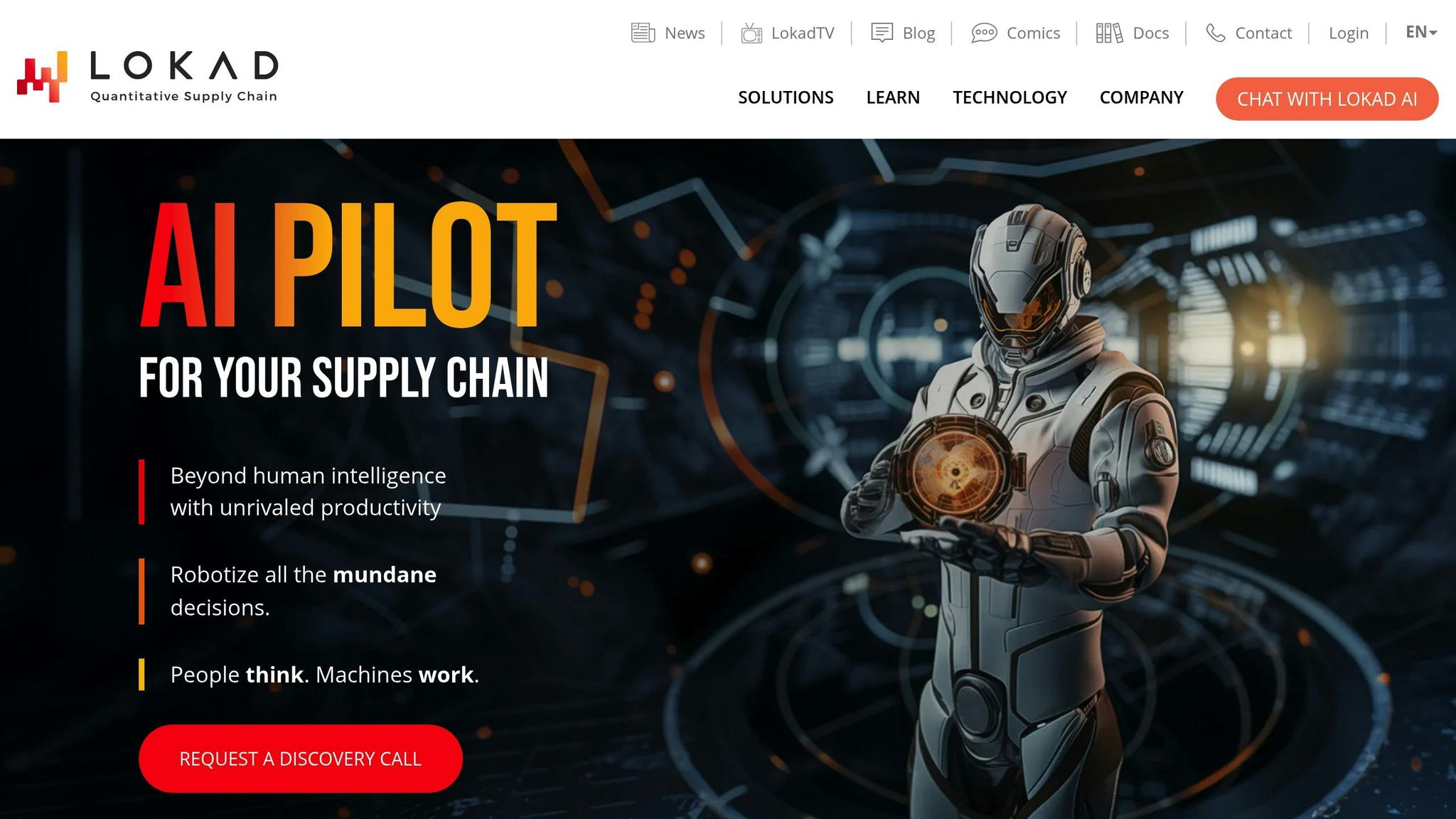
Lokad takes a probabilistic approach to forecasting, analyzing multiple demand scenarios to help businesses make smarter inventory decisions.
Lokad connects seamlessly with various business systems using native connectors and secure FTPS/SFTP protocols. Its file-based API ensures reliable data exchange, even when dealing with slower or less stable source systems. For simplified authentication, Lokad supports SSO via SAML, making it compatible with platforms like Microsoft Office 365 and Google Apps.
Here’s a snapshot of Lokad’s native integrations with popular business applications:
| Application | Type | Supported Data |
|---|---|---|
| Brightpearl | Cloud business management | Catalog, Stock, Sales Orders, Purchase Orders |
| NetSuite | Cloud ERP suite | Catalog, Stock, Sales Orders, Purchase Orders |
| Dear Systems | Inventory & warehouse management | Product lists, purchase/sales history, BOMs, supplier data |
| SkuVault Core | Warehouse management | Historical sales data via Salescast integration |
| QuickBooks | Accounting software | Sales & inventory forecast data |
These integrations allow businesses to leverage Lokad for efficient data handling while ensuring compatibility with essential tools.
Lokad’s robust integration capabilities also support its ability to process large volumes of historical data. For example, its connection with Dear Systems enables it to handle over 30 tables of business data, including product catalogs, order histories, BOMs, and supplier information. This scalability ensures that businesses can rely on Lokad to manage complex and extensive datasets with ease.
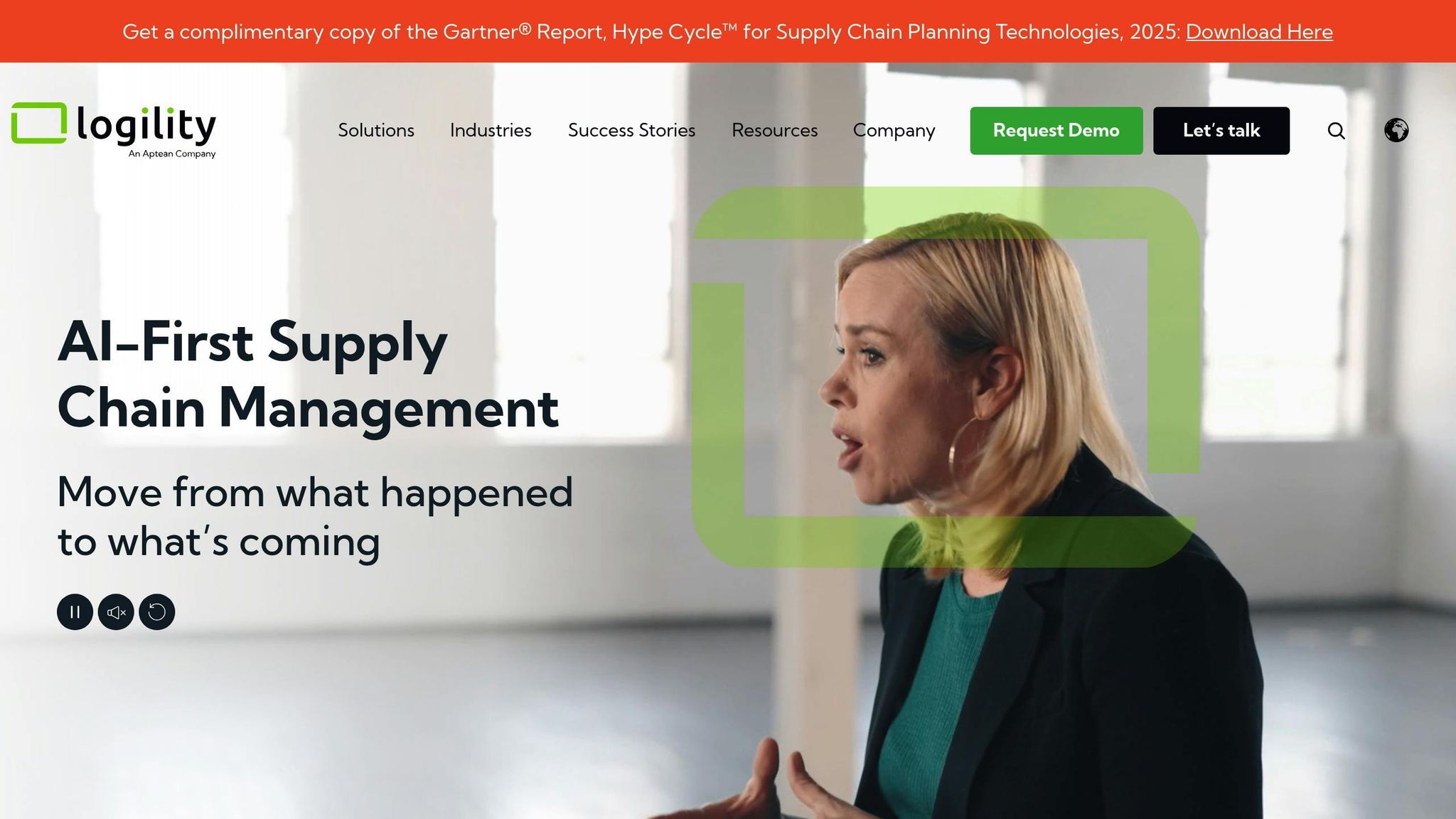
Logility delivers AI-powered demand planning that blends machine learning with statistical forecasting to streamline and enhance supply chain management.
Logility's forecasting engine leverages machine learning models to identify demand patterns, seasonal trends, and historical data insights. By using ensemble forecasting techniques - where multiple statistical models are combined - it generates more precise predictions than relying on a single method.
The platform continually evaluates and adjusts its algorithms based on their performance for specific product categories. This adaptive process improves forecasting accuracy over time as the system processes more data and fine-tunes its predictions.
Additionally, Logility integrates external variables like economic trends, weather conditions, and promotional activities into its forecasting models. This broader perspective ensures businesses can account for factors that traditional statistical methods might overlook.
This methodology reflects a shift toward more dynamic, data-informed forecasting practices in the industry.
Logility seamlessly integrates with major ERP systems such as SAP, Oracle, and Microsoft Dynamics, as well as leading cloud platforms, using pre-built connectors. These connections allow for real-time or batch data updates, depending on business needs.
The platform automates complex data transformations, cleaning and standardizing information from various sources before feeding it into forecasting models. This automation reduces the manual effort often required in data preparation, speeding up the forecasting process.
For organizations using diverse business systems, Logility's unified data layer consolidates information from databases, spreadsheets, and applications into a single, reliable source. This ensures forecasting models work with accurate and complete data, eliminating inconsistencies.
Built on a cloud-native architecture, Logility automatically scales to meet different computational demands during forecast generation. It can handle millions of SKUs across multiple locations without compromising performance.
The platform supports hierarchical forecasting, allowing businesses to analyze demand at both granular levels (like individual SKUs) and broader levels (such as overall company demand). This flexibility ensures that forecasting aligns with specific organizational goals and reporting needs.
Dynamic scaling ensures businesses only pay for the computational resources they require, especially during peak forecasting periods, making it a cost-efficient solution.
Logility operates on a subscription-based pricing model, with costs determined by the number of SKUs forecasted, data volume processed, and the modules included in the deployment. Pricing starts with basic demand planning features and can expand to include advanced tools like supply chain optimization and inventory planning.
Implementation costs range from $50,000 to $500,000, with annual subscription fees typically set at 15-20% of the initial cost. Most deployments include professional services for setup, user training, and ongoing support.
The platform also offers flexible licensing, enabling businesses to start with core functionalities and add features like promotional planning or new product forecasting as their needs grow.
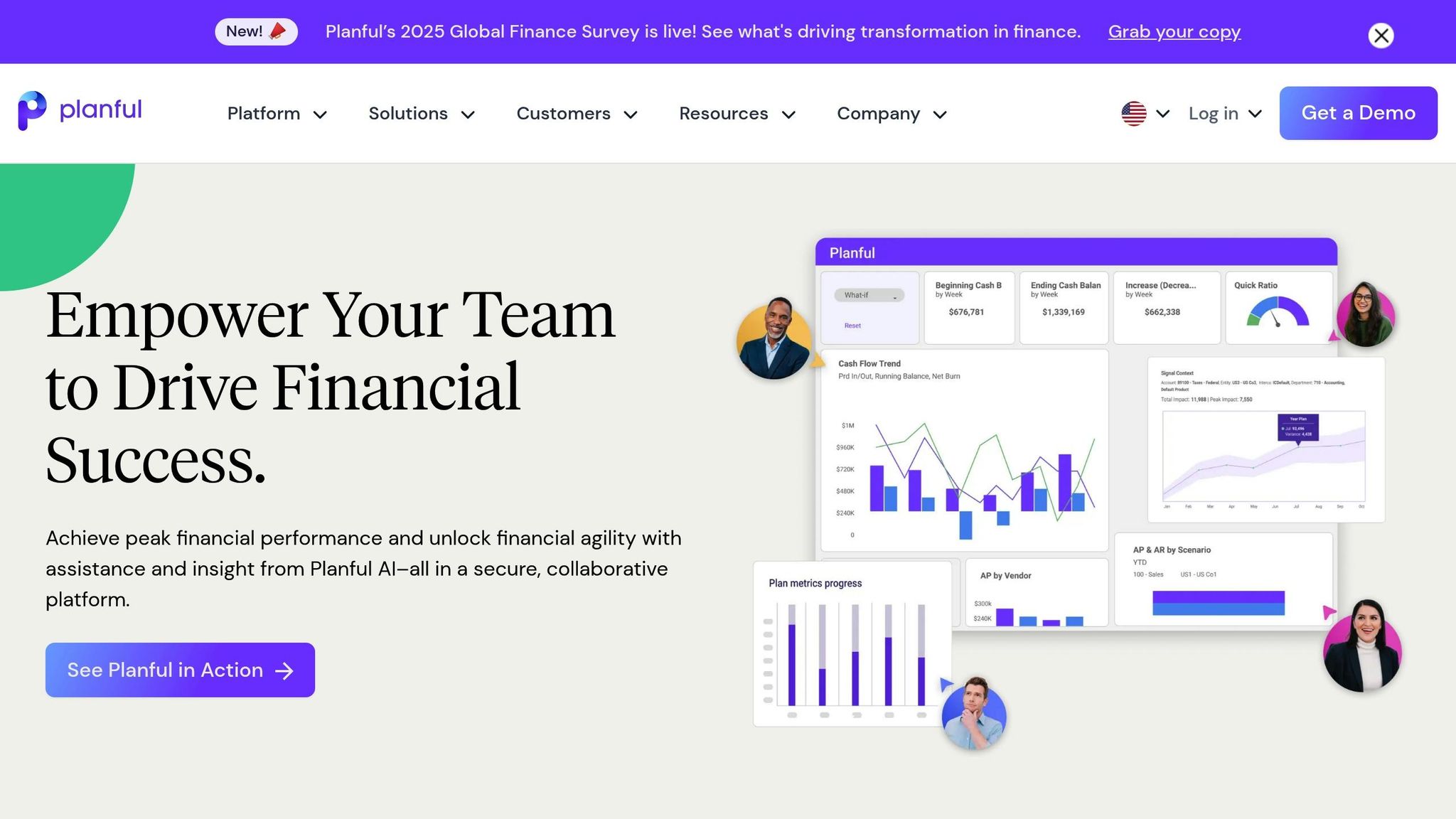
Planful is a continuous planning platform that combines traditional financial forecasting with machine learning, helping businesses stay agile in shifting markets.
Planful employs a mix of quantitative and qualitative forecasting techniques, tailored to the data available. For organizations with abundant data, it uses quantitative methods like straight-line projections, moving averages, linear regressions, and time series analysis to identify trends. In cases where data is limited, it leans on qualitative approaches and scenario-based forecasting to account for subjective factors. Machine learning plays a key role by automating pattern recognition, detecting anomalies, and running scenario analyses to model potential outcomes, including worst-case scenarios.
This forecasting approach integrates effortlessly with enterprise systems, ensuring a cohesive planning process.
Planful simplifies data integration by automatically pulling operational and financial data from existing business systems. This ensures that forecasts are built on real-time, accurate data, enabling businesses to make faster, more informed decisions.
Planful doesn’t stop at accurate forecasting - it continuously updates predictions. With its continuous planning model, businesses can regularly refresh their forecasts, making it easier to respond quickly to evolving market conditions.
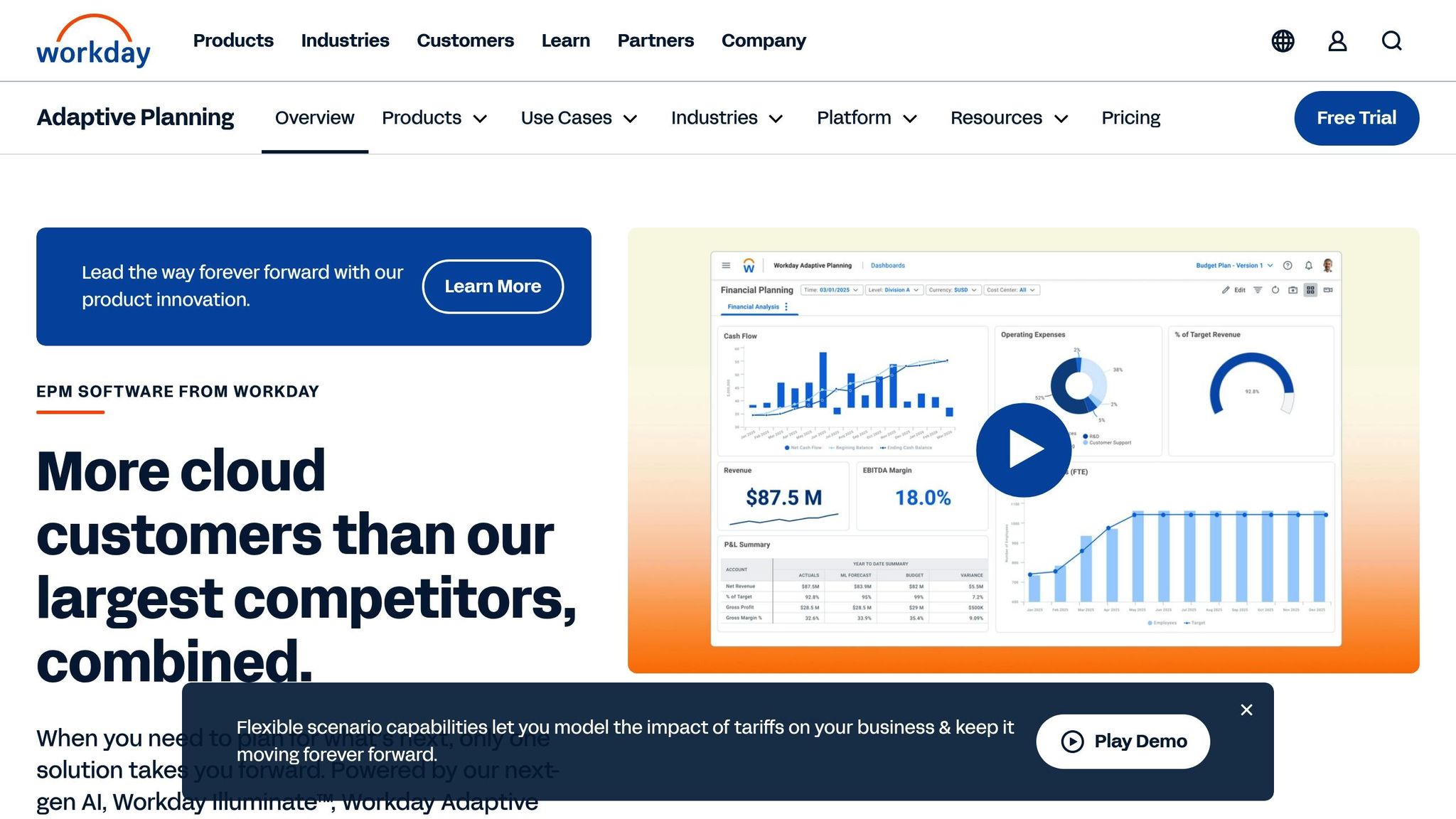
Workday Adaptive Planning is a cloud-based platform designed to simplify financial planning and analysis for businesses. It helps finance teams streamline workflows and improve the accuracy of their forecasting processes.
This platform uses automation to analyze historical data, uncovering trends and patterns like seasonality. It combines structured financial data with essential business metrics, creating models that offer realistic projections. Users can also review anomalies and make adjustments to ensure predictions stay on track. One standout feature is driver-based modeling, which links financial outcomes directly to specific business metrics. This approach not only improves forecasting but also lays a strong foundation for integrating with other systems.
Workday Adaptive Planning seamlessly connects with key enterprise systems, making data integration straightforward. It works effortlessly with Workday’s own suite, including its Human Capital Management (HCM) and Financial Management tools. Beyond that, it offers pre-built connectors and API-based integrations for popular ERP systems like SAP, Oracle, and Microsoft Dynamics. This flexibility ensures that businesses can pull data from various sources without hassle.
Thanks to its cloud-based infrastructure, the platform is built to scale alongside your business. Whether you’re a mid-market company or a large enterprise, it can handle peak periods and support multiple planning scenarios. This makes it easier for teams to create and compare forecasts tailored to different market conditions.
The platform’s pricing model is subscription-based, adjusting to the number of users and the specific modules selected. Costs vary depending on the scale of your operations and the level of customization required. Most businesses sign annual agreements, with implementation costs depending on the complexity of integrations and customizations needed for their setup.

Vena makes its mark in the AI forecasting world by blending the familiarity of Excel with the power of machine learning. Its predictive analytics tools help businesses refine the accuracy of their financial forecasts.
Vena's forecasting system uses machine learning to process large datasets effectively. It creates versioned forecasts for metrics like unit sales and pricing, tailored to specific drivers. For instance, a bike manufacturer might use the Consumer Confidence Index as a key driver for predictions.
The platform offers two main forecasting options:
"Models learn real drivers for materially lower error compared to traditional methods." - element61
In addition to machine learning, Vena supports traditional forecasting methods, including top-down, bottom-up, driver-based, and zero-based budgeting. Its forthcoming Vena Copilot AI will integrate directly into Excel, enabling finance teams to tweak forecasts without overwriting the original data.
"Finance teams remain in control: No need to stick with model predictions. Adjusted scenarios allow manual adaptations." - element61
This versatile forecasting framework ensures flexibility and precision while maintaining seamless data integration, as explored below.
Vena further enhances its functionality by integrating with Databricks and Excel. The Excel integration is particularly valuable, allowing users to work within a familiar interface while leveraging AI-powered forecasting tools. This setup ensures easy adoption without disrupting existing workflows.
Thanks to Databricks, Vena scales effortlessly to handle massive datasets and multiple forecasting scenarios at once, making it a strong choice for businesses managing complex data environments.
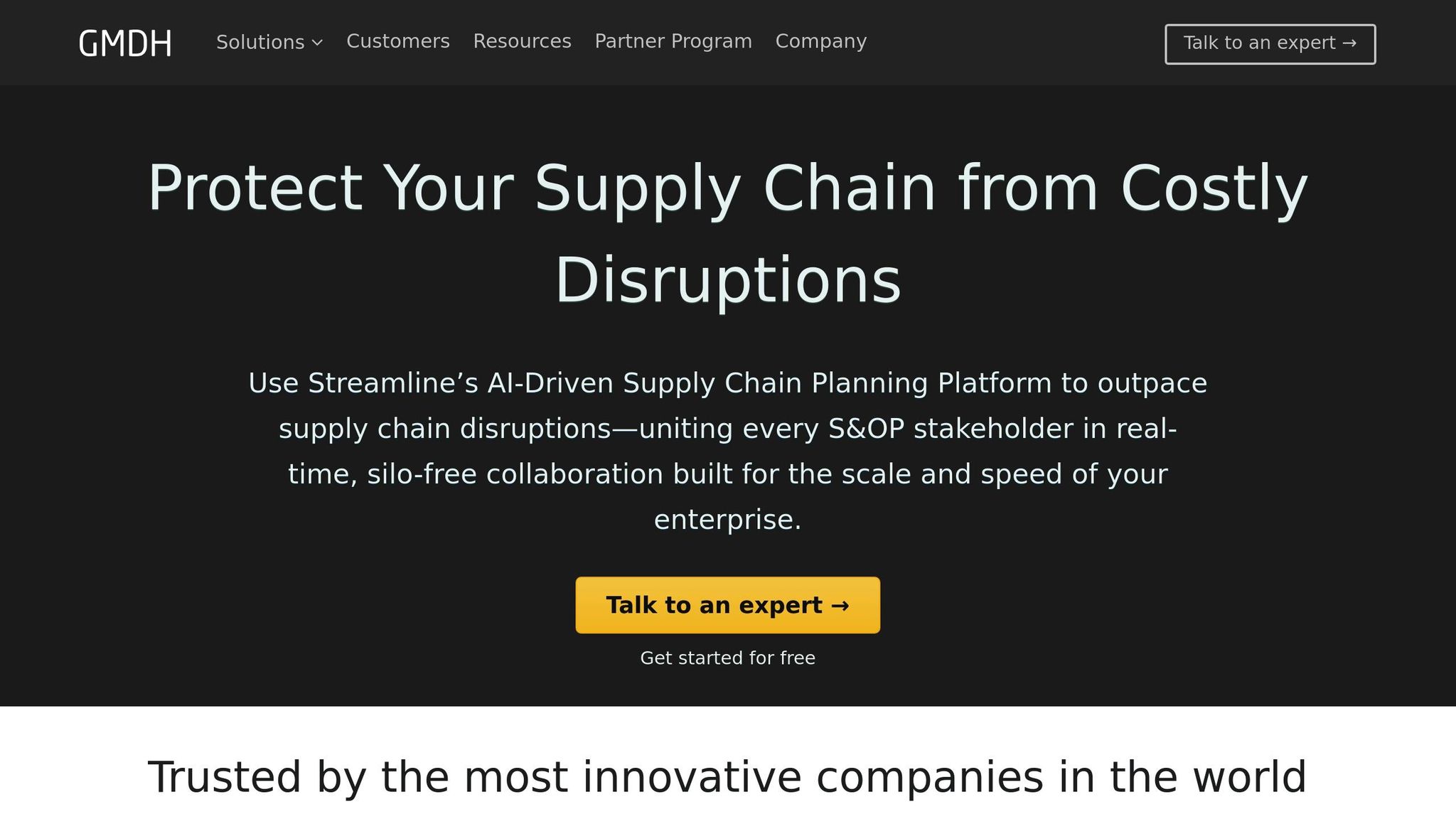
After exploring platforms like Netstock and Logility, GMDH Streamline stands out for its specialized focus on inventory forecasting. It’s designed to tackle the challenges of demand planning and supply chain management, particularly for businesses dealing with complex inventory needs.
GMDH Streamline leverages the Group Method of Data Handling (GMDH) algorithm, a self-organizing neural network technique. This approach builds optimal forecasting models automatically, eliminating the need for manual intervention. Unlike traditional statistical methods, GMDH creates polynomial networks that pinpoint the most relevant input variables and their interactions.
The system is adept at managing seasonality, trends, and irregular demand patterns. It creates layered polynomial models where each layer processes input variables and selects only the most predictive relationships for the next stage. This evolutionary process ensures the platform finds the best model structure for each SKU, sparing users from having to choose specific algorithms.
One of its standout capabilities is intermittent demand forecasting, which is crucial for businesses with sporadic sales patterns. The algorithm identifies hidden demand drivers that traditional methods often overlook, making it especially effective for slow-moving inventory.
GMDH Streamline integrates seamlessly with major ERP systems like SAP, Oracle, Microsoft Dynamics, and NetSuite, using standard data connectors. It also supports CSV file uploads and database connections, making it easy to implement within existing data infrastructures.
The platform offers real-time data synchronization, ensuring forecasts reflect up-to-date inventory levels, sales activity, and supply chain disruptions. It can process data from multiple warehouses and distribution centers simultaneously, providing a unified view of demand planning across complex networks.
Whether a business manages hundreds or millions of SKUs, GMDH Streamline scales effortlessly. Its automated model-building process minimizes computational strain, even when handling extensive product catalogs.
The platform supports hierarchical forecasting, enabling predictions at multiple levels - product family, category, or individual SKUs. This flexibility helps businesses align their day-to-day inventory decisions with long-term strategic goals.
GMDH Streamline operates on a subscription-based pricing model, starting at around $500 per month for small businesses managing up to 1,000 SKUs. For mid-sized companies, pricing typically ranges between $2,000 and $10,000 per month, depending on the number of SKUs and required features.
Enterprise pricing is customized based on factors like data volume, integration complexity, and support needs. Thanks to its automated model-building capabilities, implementation costs are often lower than competitors, as it reduces the reliance on extensive consulting services.
GMDH Streamline is a strong choice for businesses that prioritize inventory forecasting and supply chain efficiency over broader financial planning tools. Its targeted approach makes it an excellent complement to more comprehensive platforms.
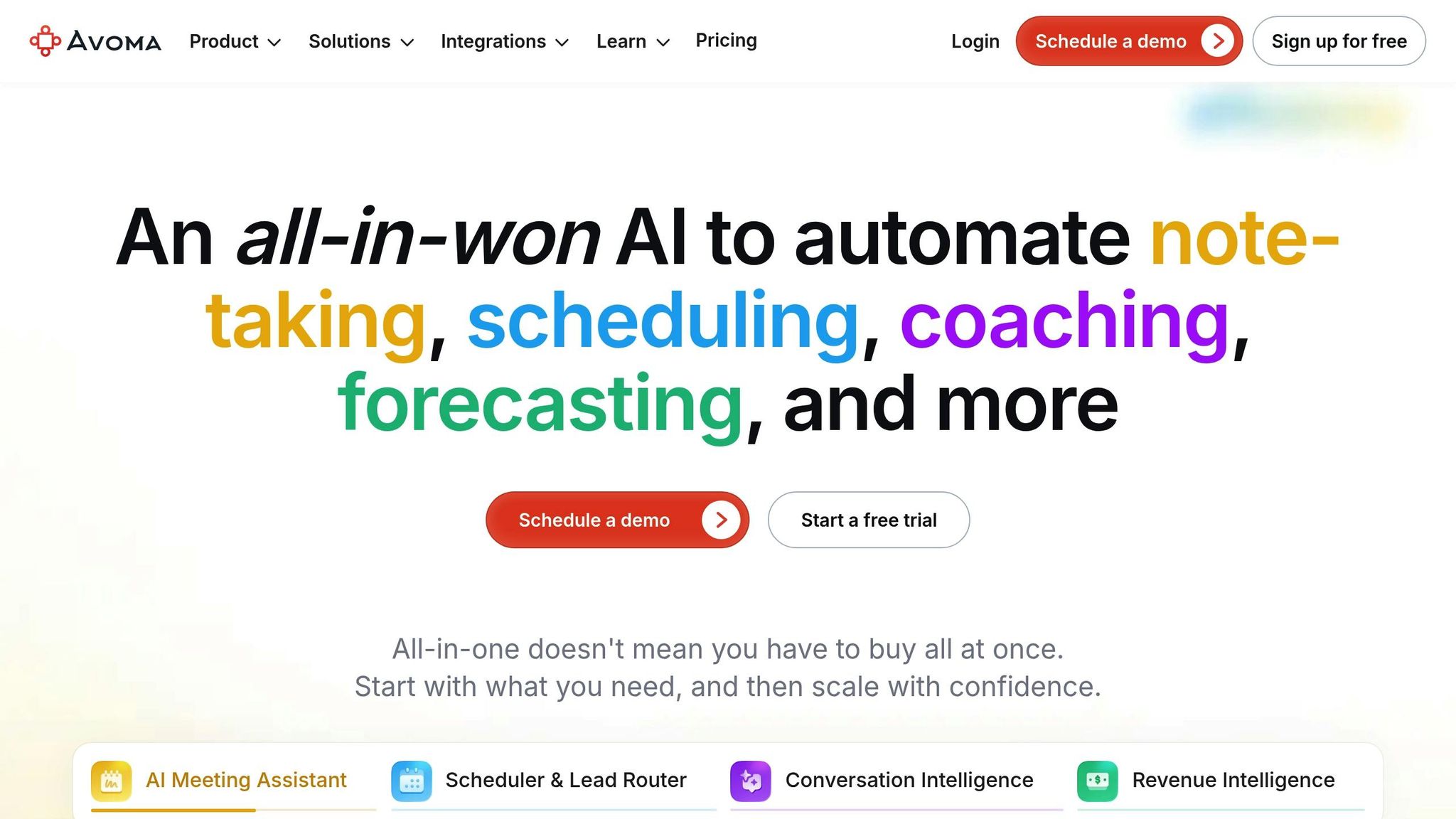
Avoma stands out in the world of AI tools by focusing on conversation intelligence to help sales teams uncover actionable insights from their interactions. Unlike traditional forecasting tools that concentrate on inventory or financial planning, Avoma zeroes in on analyzing recorded meetings and sales calls to pinpoint the factors that shape successful sales strategies.
Avoma leverages natural language processing (NLP) and machine learning to transcribe and analyze meetings and calls. It identifies key elements like sentiment changes and critical discussion points - such as budgets or timelines - that can directly influence sales approaches.
The platform integrates effortlessly with popular video conferencing tools like Zoom, Microsoft Teams, and Google Meet, as well as calendar apps. This setup allows for automatic call capture, recording, and transcription, eliminating the need for extra manual steps while ensuring every interaction is documented for analysis.
Avoma is designed to accommodate both small teams and large enterprises. Its features include multi-language support, making it a valuable resource for global teams. For larger organizations, the platform can be customized to reflect specific sales workflows and terminology, ensuring it aligns perfectly with unique business needs.
Avoma operates on a per-user monthly subscription model, offering tiered plans. These range from basic conversation recording to advanced analytics at higher tiers. For enterprise clients with more complex needs, custom pricing options are available, providing a predictable and scalable cost structure as teams expand.
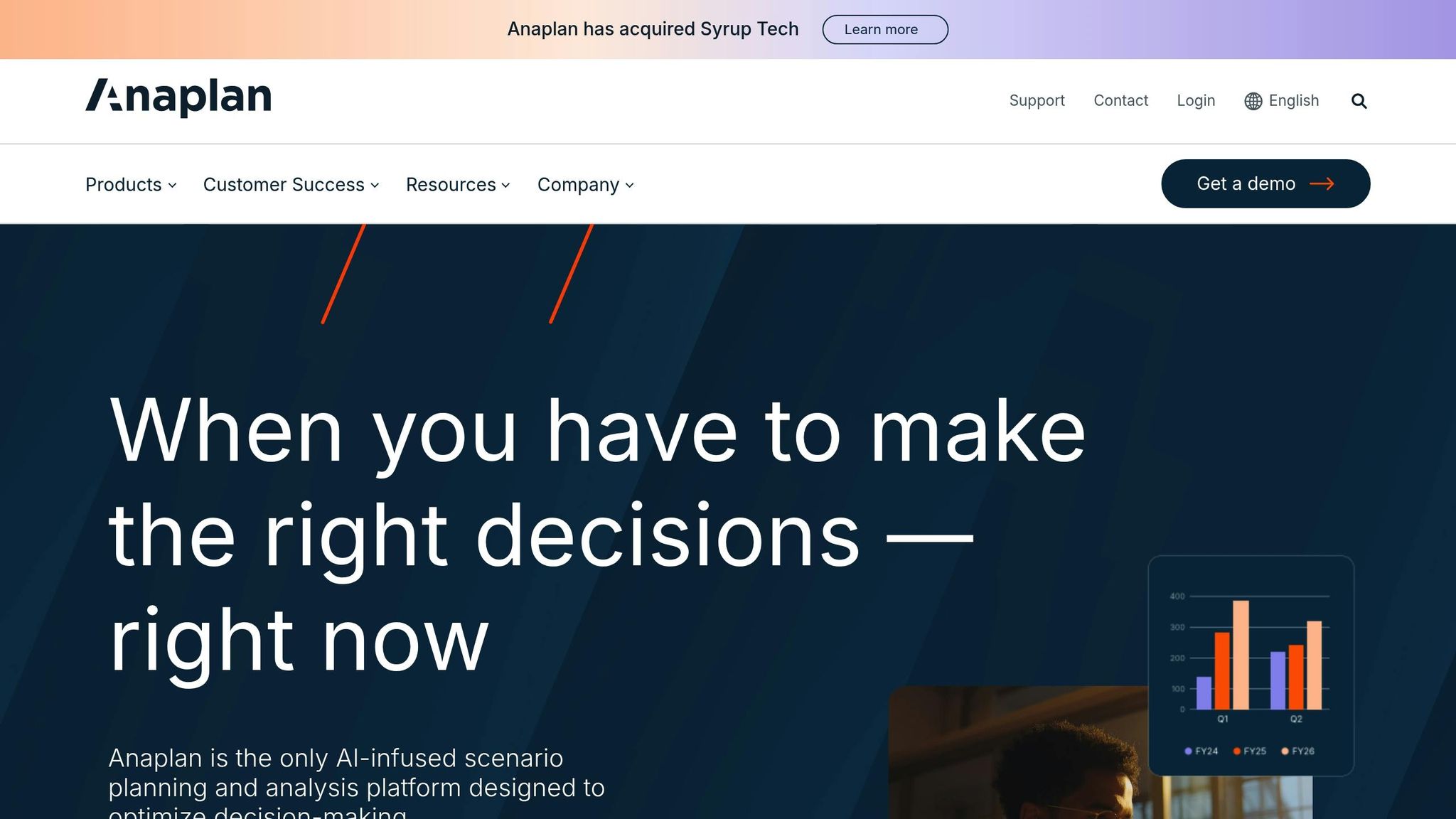
Anaplan stands out by offering connected planning that integrates supply chain, finance, HR, operations, and sales into a unified platform. Unlike tools that focus on a single function, Anaplan manages complex structures and handles large datasets across various business models.
Anaplan leverages real-time data to create dynamic forecasts and simulate "what-if" scenarios. These scenarios allow businesses to test different assumptions and evaluate potential outcomes. This scenario-based forecasting is seamlessly integrated with Anaplan's powerful suite of connectivity tools.
Anaplan offers a wide range of integration tools designed to work with both on-premise and cloud-based systems.
At the heart of its integration capabilities is the Data Orchestrator, which acts as a hub for connecting systems. It includes pre-built connectors for tools like SAP, Salesforce, and Snowflake, along with ETL (Extract, Transform, Load) capabilities and scheduling features. For cloud storage, the CloudWorks tool enables no-code connections to services like AWS S3, Google BigQuery, and Microsoft Azure Blob.
For on-premise needs, Anaplan Connect provides a command-line utility for batch data transfers and database connections via JDBC. Developers can also take advantage of REST, Transactional, and Bulk APIs to build custom integrations tailored to their specific requirements.
Anaplan also offers HyperConnect, free for organizations that already have an Informatica Cloud license. For others, it can be purchased as part of an Anaplan agreement. Additionally, the platform integrates with third-party ETL tools like MuleSoft and Informatica, though these require separate licenses.
Built for enterprise-level operations, Anaplan is designed to handle the needs of large organizations. It supports complex hierarchies and allows multiple business units with unique planning cycles to operate within the same platform. For global companies, it also supports multi-regional deployments, ensuring compliance with data residency requirements while maintaining centralized planning processes.
Anaplan operates on a subscription-based pricing model, with costs determined by factors like the number of users, data volume, and selected features. Core integration tools such as Anaplan Connect, APIs, and CloudWorks are included at no additional charge. For enterprise-level pricing, businesses can work directly with Anaplan’s sales team to create a customized plan.
The platform reviews above provide a detailed look at various tools, but here's a quick summary of their main strengths and challenges. This breakdown can help organizations weigh the trade-offs and choose a solution that aligns with their goals and budget.
Enterprise-level platforms like Anaplan and Workday Adaptive Planning are designed for large organizations with complex, multi-departmental planning needs. They shine in integration and data management but come with steep learning curves and high implementation costs, which can be daunting for smaller businesses.
Specialized inventory tools such as Netstock and Lokad focus on supply chain forecasting and offer features tailored to specific industries. However, their narrow scope means businesses looking for broader planning capabilities may need to invest in additional software.
Mid-market solutions like Planful and Vena offer a middle ground, combining robust financial planning with user-friendly interfaces. While they’re less complex than enterprise tools, they may fall short in advanced AI features or scalability for fast-growing companies.
Here’s a table summarizing the key advantages and limitations of each platform:
| Tool | Key Advantages | Primary Limitations |
|---|---|---|
| Netstock | Specialized inventory optimization, industry-specific features, strong ROI tracking | Limited to supply chain planning, may need integration with other systems |
| Lokad | Advanced probabilistic forecasting, handles complex supply chains, strong automation | Steep learning curve, primarily focused on inventory management |
| Logility | Comprehensive supply chain suite, proven scalability, strong analytics | High implementation costs, complex setup process |
| Planful | User-friendly interface, solid financial planning, suitable for mid-market use | Lacks advanced AI features, may not scale for very large enterprises |
| Workday Adaptive Planning | Seamless HR integration, enterprise-grade security, collaborative planning | Expensive for smaller organizations, requires extensive training |
| Vena | Familiar Excel-like interface, flexible reporting, strong implementation support | Limited advanced forecasting capabilities, lacks industry-specific features |
| GMDH Streamline | Automated model selection, handles missing data well, budget-friendly | Less suitable for complex multi-departmental planning, limited customization |
| Avoma | Conversation intelligence integration, sales-focused insights, easy deployment | Narrow use case focus, lacks financial planning features |
| Anaplan | Highly scalable, comprehensive integration tools, supports complex hierarchies | High learning curve, expensive total cost of ownership |
When it comes to pricing, deployment, and integration, options vary widely. Tools like GMDH Streamline are simple and cost-effective, making them a good fit for smaller teams. On the other hand, enterprise solutions like Anaplan and Workday Adaptive Planning require larger investments, longer implementation timelines, and more intricate integrations.
Choosing the right AI forecasting platform comes down to aligning the tool with your organization's size, industry focus, and budget. With nine platforms reviewed, the key takeaway is clear: the best tool is the one that fits your unique business needs - not just the one loaded with features.
For large enterprises, scalability and robust integration are often top priorities, even if they come with higher costs for training and implementation. On the other hand, small to mid-sized businesses typically benefit from tools that are more affordable and easy to use, especially when tailored to specific tasks.
Specialization is another critical factor. For example, companies focusing on supply chain management might find specialized tools more effective, while those with broader financial planning needs may prefer more flexible platforms.
Don’t overlook the total cost of ownership. This includes not just licensing fees but also the complexity of implementation and any consulting or support services required.
For a more detailed breakdown of features, strengths, and limitations, refer back to the earlier sections. The insights provided aim to help you select a forecasting tool that aligns perfectly with your business goals and objectives.
To pick the best AI forecasting tool for your business, start by pinpointing your specific needs. Are you focusing on financial planning, demand forecasting, or scenario analysis? Understanding your goals will help narrow down the options.
Next, consider how well the tool fits your industry’s unique demands and long-term strategies. Does it address the challenges your business faces? Take into account factors like your organization’s complexity, the tool’s data integration capabilities, and, of course, your budget. It’s also crucial to find a solution that meshes with your current workflow and offers features designed for your industry.
By choosing a tool that checks these boxes, you’ll position your business to make better decisions and use resources more efficiently.
The price of AI forecasting tools can vary widely, influenced by several factors such as the complexity of the project, the volume of data required, the technology powering the tool, and the scale at which it will be deployed. Broader economic conditions, including inflation and market trends, can also play a role in determining costs.
When calculating the total cost of ownership (TCO), it's important to account for all expenses throughout the tool's lifecycle. This includes upfront costs like licensing fees or software purchases, as well as ongoing costs such as data storage, processing, maintenance, and staffing. By factoring in these elements, businesses can get a clearer understanding of the long-term financial commitment involved.
When choosing an AI forecasting tool, prioritize features that allow real-time data syncing across various sources. It's also essential that the tool works smoothly with your existing financial and operational systems while supporting automated workflows. These elements help ensure accurate predictions and smooth data sharing, empowering you to make well-informed decisions without interruptions.
You should also consider tools with straightforward API access and pre-built connectors for popular software. This can simplify the setup process and ensure the tool integrates effortlessly into your current operations.





